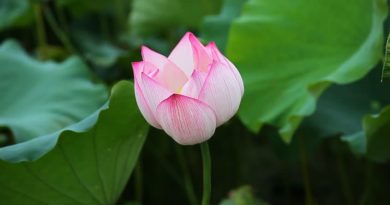FUNDAMENTALS OF VIPASSANA MEDITATION – CHAPTER III: Knowledge And Freedom
“Insight meditation is meditating on the five aggregates of grasping.” This is in accordance with the teachings of the Buddha. The teachings of the Buddha are called Suttas, which means “thread”. When a carpenter is about to plane down or saw off a piece of timber he draws a straight line using a thread. In the same way when we want to live the holy life we use the “thread” or Sutta to draw straight lines in our actions. The Buddha has given us lines or instructions on how to train in morality, develop concentration and make become wisdom. You cannot go out of the line and speak or act as you please. Regarding the meditation of the five aggregates, here are a few excerpts from the Suttas:
“Material shape, monks, is impermanent. What is impermanent, that is suffering. What is suffering, that is not the self. What is not self, that is not mine, that am I not, this is not my self. As it really comes to be, one should discern it thus by right wisdom.”
Samyutta ii 19
You must meditate so that you will realise this impermanent, suffering, not self material form is really impermanent, dreadfully suffering, and without a self or ego. You should meditate likewise on feelings, perception, activities and consciousness. What is the use of looking upon these aggregates as impermanent suffering and not self? The Buddha tells us
“So seeing all these things, the instructed disciple of the Ariyans disregards material shape, disregards feeling.”
Samyutta iii 68
He who realises the impermanent, suffering, not self nature of the five aggregates is wearied of material form as he is of feelings, perception, activities and consciousness.
“By disregarding he is passionless.”
That is to say, he has reached the Ariyan Path.
“Through passionlessness, he is freed.”
Once he has reached the Ariyan path of passionlessness, he has arrived at the four fruitions of freedom from the defilements, too.
“In freedom the knowledge comes to be I am freed.”
When you are freed, you know for yourself that you are so. In other words, when you have become an arahat in whom the defilements are extinguished, you know you have become one.
All these excerpts are from Yad anicca Sutta and there are numerous Suttas of this kind. The whole Khandhavagga Samyutta is a collection of them. Two Suttas are especially noteworthy: Silavanta Sutta and Sutavanta Sutta. In both Suttas the venerable Maha Kotthika puts some questions to the venerable Sariputta, who gives very brief but vivid answers. Maha Kotthika asks:
“What things, friend Sariputta, should be attended to thoroughly by a monk of moral habit?”
Note the attribute “of moral habit in this question. If you want to practise insight meditation with a view to attaining the Path and Fruition and Nirvana, the least qualification you need is, to be of moral habit. If you dont even have moral habit, you cant hope for the higher conditions of concentration and wisdom. The Venerable Sariputta answers:
“The five grasping aggregates, friend Kotthika, are the things which should be thoroughly attended to by a monk of moral habit, as being impermanent, suffering, as a disease, as a boil, as a dart, as pain, as illness, as alien, as decay, as void, as not self.”
What is the good of meditating like that? In answer the Venerable Sariputta goes on:
“Indeed, friend, it is possible for a monk of moral habit so thoroughly attending to these five aggregates of grasping” to realise the fruits of stream winning.
So, if you want to be a Stream winner and never to be reborn in the four lower states, you have to meditate on the five aggregates to realise their impermanence, suffering, and not self nature. But that is not all. You can become an Arahat, too. The Venerable Kotthika goes on to ask:
“What things, friend Sariputta, should be attended to thoroughly by a monk who is a Stream winner?”
The Venerable Sariputta answers that it is the same five aggregates of grasping that should be thoroughly attended to by a Stream winner, as impermanent, suffering, not self. The result? He moves on to Once returning. What does a Once returner meditate on? Again the same five aggregates of grasping. He then becomes a Non returner. What does the Non returner meditate on? The five aggregates again. Now he becomes an Arahat. What does the Arahat meditate on? The five aggregates again. From this it is clear that the five aggregates are the things one has to meditate on even when one has become an Arahat.
What good is it to the Arahat by meditating so? Will he become a silent Buddha? Or, a supreme Buddha? No, neither. He will end his round of rebirths as an Arahat and enter Nirvana. The Arahat has no defilement left unremoved or uncalmed yet. All the defilements have been removed and calmed. So, he has nothing to develop in order to remove the defilements left unremoved or to calm those left uncalmed. Neither has he any moral habit, concentration or wisdom yet to perfect. All the moral habits, concentration and wisdom that ought to be perfected have been perfected in him. So, he has no need to work for the perfection of what ought to be perfected, nor has he any need to increase those already perfected. The insight practice brings no such benefits to the Arahat.
One of the benefits the Arahat receives by meditating on the five aggregates is the happy condition in this world. Notwithstanding his being an Arahat, if be remains without meditation, disquiet and discomfort keep coming up at the six sense doors, now here, now there. Here, disquiet does not mean mental distress. As the sense objects keep coming up despite himself, he finds no peace of mind. That is all. Not to speak of Arahats, our meditators of today feel ill at ease to meet with the sense objects, eager though they are on insight. As they return home from the meditation centres they see this thing, hear that thing, get engaged in such and such business talks, and there is no peace at all. So they come back to the centre.
To some, however, the disquiet does not last very long. Just four, five or ten days. Very soon the homely spirit gets the better of them and they are happy with their home life and set to household cares again. The Arahat never returns to his old habits. If he meets with various sense objects without meditation, only disquiet results. Only when he is absorbed in insight meditation does he find peace of mind. Thus meditating on the five grasping aggregates brings to the Arahat happy condition in this world.
Again, as he lives in earnest meditation, mindfulness and comprehension of the impermanence, suffering and not self keep rising in him. This is another benefit. The Arahat in whom mindfulness and comprehension keep rising is said to be in a chronic state of life. Such a one can enjoy the attainment to fruition at any time and for as long as he desires. For these two benefits – a happy condition in this world and mindfulness comprehension – the Arahat lives in meditation.
The above are the answers given by the Venerable Sariputta in Silavanta Sutta. The same answers are found in Sutavanta Sutta too. The only difference is in the terms silavanta, “of moral habit” or “virtuous”, and sutavanta, “instructed” or “well informed.” All the other words are the same. Based on these two Suttas and other Suttas on the aggregate the dictum has been formulated: Insight knowledge comes from meditating on the five aggregates of grasping.
Now to come back to the grasping that rises through the six sense doors.
When people see, they think of themselves or others as being permanent, as having existed before, as existing now, as going to exist in future, as existing always. They think of them as being happy, good, or beautiful. They think of them as being living entities. They think likewise when they hear, smell, taste or touch. This “touch” is widespread all over the body – wherever there is flesh and blood. And wherever touch arises, there arises grasping. The bending, stretching, or moving of the limbs mentioned earlier are all instances of touch. So are the tense movements of rising and falling in the abdomen. We will come to this in detail later.
When one thinks or imagines, one thinks, “The I that have existed before am now thinking. Thinking, I go on existing,” and so one thinks of oneself as being permanent, as an ego. One also thinks the thinking or imagining as being enjoyable, as being very nice. One thinks it is happiness. If told that the thinking will disappear, he cannot accept it. He is not pleased. This is because he is clinging to it.
In this way one clings to whatever comes through the six sense doors, as being permanent, as being happy, as ego, as self. One delights with craving and clings to it. One mistakes with wrong view and cling to it. You have to meditate on the five aggregates that can clings or grasp.






